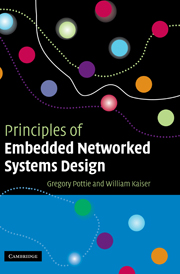Book contents
- Frontmatter
- Contents
- Preface
- Acknowledgments
- List of Abbreviations
- 1 Embedded network systems
- 2 Representation of signals
- 3 Signal propagation
- 4 Sensor principles
- 5 Source detection and identification
- 6 Digital communications
- 7 Multiple source estimation and multiple access communications
- 8 Networking
- 9 Network position and synchronization services
- 10 Energy management
- 11 Data management
- 12 Articulation, mobility, and infrastructure
- 13 Node architecture
- 14 Network data integrity
- 15 Experimental systems design
- 16 Ethical, legal, and social implications of ENS
- 17 Design principles for ENS
- Appendix A Gaussian Q function
- Appendix B Optimization
- Index
15 - Experimental systems design
Published online by Cambridge University Press: 10 August 2009
- Frontmatter
- Contents
- Preface
- Acknowledgments
- List of Abbreviations
- 1 Embedded network systems
- 2 Representation of signals
- 3 Signal propagation
- 4 Sensor principles
- 5 Source detection and identification
- 6 Digital communications
- 7 Multiple source estimation and multiple access communications
- 8 Networking
- 9 Network position and synchronization services
- 10 Energy management
- 11 Data management
- 12 Articulation, mobility, and infrastructure
- 13 Node architecture
- 14 Network data integrity
- 15 Experimental systems design
- 16 Ethical, legal, and social implications of ENS
- 17 Design principles for ENS
- Appendix A Gaussian Q function
- Appendix B Optimization
- Index
Summary
There are large gaps between theory, simulations, laboratory experiments, field experiments, and field deployments, essentially related to the acceptable degree of human intervention permitted to change the system, i.e., getting things to work. A research program typically loops through these stages as experimental results suggest new directions for theory. The basic assumption of this chapter is that since ENS are fundamentally about connecting the physical world to large scale networks, therefore physical experiments must be performed to verify their proper operation. It is necessary to make simplifying assumptions in early design stages, but no system that is designed to interact with the real world can really be trusted without a set of real deployments that test these assumptions. This chapter describes the basic design stages of the development of experimental systems from the formulation of objectives and assembly of the design and application team through deployment. Throughout, a robotic NIMS is used as an example (see Chapter 12 for background).
Deciding on priorities
The most important decision in the whole process is the set of priorities. What particular problems will the system solve? Can slightly different problems be addressed at much less cost and effort? Who will need to be consulted or be on the design team to help determine the problem formulation? The notion of an experiment most of us carry around is based on the formal high school/university laboratory report with objectives, theory, method, results, analysis, and conclusion.
- Type
- Chapter
- Information
- Principles of Embedded Networked Systems Design , pp. 463 - 474Publisher: Cambridge University PressPrint publication year: 2005



